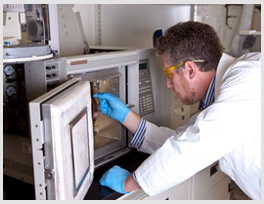


Materials Identification
Materials identification is used in cases where a material in question needs to be accurately identified. During analysis, the sample is routinely subjected to optical and electron microscopy, X-Ray Diffraction (XRD), X-ray Fluorescence Spectrometry (XRF), Thermo-Gravimetric Analysis (TGA), Differential Scanning Calorimetry (DSC) and Fourier Transform Infrared Spectrometry (FTIR).
In addition, Gas Chromatography/Mass Spectrometry (GC/MS) and a host of chemical tests may also be employed to identify the components within the sample.
Examples of common Material Identifications include:
• Identification of dusts found in buildings (homes, schools, industrial settings and manufacturing).
• Identification of material on walls, floors, in pipes, drums and filters.
• Identification of material or liquids leaching from under floors or tanks.
• Identification of contaminants within potable water, oil, food and other matrices.
• Identification of liquids, slimes, chemicals or unknowns found on properties.
• Identification of stains found in buildings and contents.
• Identification of combustible dusts.
• Identification of raw materials.
• Identification of unknowns.

Contaminant Identification
Unknown items found in materials and products typically results in manufacturers wanting to quickly identify the source. This process involves advanced analytical techniques and expertise. EMSL’s scientists have years of experience identifying contaminants from the environment, improper storage practices and due to poor raw materials.
To accomplish this task, EMSL’s scientists often incorporate their chemical analysis capability of infrared spectroscopy (IR) to microscopy. Their scientists have extensive experience in compositing the spectroscopic analysis by Fourier Transform Infrared Spectroscopy (FTIR) with microscopic examination.
EMSL’s IlluminatIR® interfaced with a light microscope and an attenuated total reflection (ATR) objective allows regions as small as 15 µm to be simultaneously observed and analyzed for identification of functional groups present in the molecular structure. This micro-FTIR analysis is valuable in such varied applications as the determination of contaminants, quality assurance, product comparison, screening for biological agents in powder mixtures and the identification of unknown substances.
IR microspectroscopy regularly demonstrates its effectiveness in many applications. Other techniques such as elemental X-ray mapping and Auger electron spectroscopy (AES) are also frequently used to provide additional chemical and morphological information for unknown substances.
In addition, EMSL also routinely utilizes GC/MS, XRD, XRF, DSC, PLM, SEM/EDX and LECO CHN & CS to help identify contaminants.
Materials Characterization
EMSL’s Materials Characterization division provides expertise in characterizing all types of materials. These services are used to identify materials, properties, composition, contaminants, purity, impurities and other services.
In addition, our Materials Characterization division provides:
• Accelerated Environmental Exposure
• Dielectric Properties
• Film Thickness
• Flash Point
• Melt Flow
• Particle Size
• Rheology
• Specific Gravity & Density
• Specific Heat Capacity

